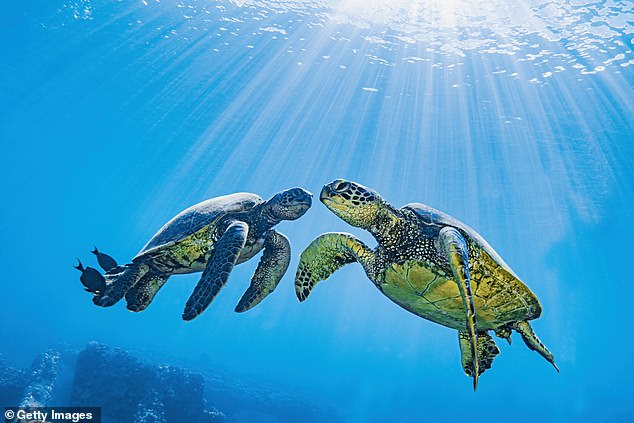Green turtles have been rescued from the brink of extinction thanks to global conservation efforts.
The marine reptiles – once hunted for their eggs, decorative shells and to be used in turtle soup – have been listed as endangered since the 1980s.
Now initiatives to preserve the species, such as releasing hatchlings on beaches and protecting eggs, mean they are no longer facing the threat of extinction.
Data shows the green turtle population rebounding in a feat being hailed a major conservation victory by scientists.
It comes after the Daily Mail launched its ‘Banish the Bags’ campaign back in 2008 with a front page image of an endangered green turtle tangled in a trail of plastic bags.
Our crusade led to the introduction of a 5p charge on plastic shopping bags which resulted in more than nine billion fewer being used every year.
Dr Nicolas Pilcher, of the Marine Research Foundation, a non-profit organisation based in Malaysia, said yesterday: ‘We must use this win as a catalyst to achieve numerous other wins.’
The latest list of endangered species, known as the Red List, was announced in Abu Dhabi at the International Union for the Conservation of Nature. Some 172,000 species are on the list, which is categorised based on the severity of threat.

Green turtles have been listed as endangered since the 1980s. Now initiatives to preserve the species, such as releasing hatchlings on beaches and protecting eggs, mean they are no longer facing the threat of extinction
If numbers start to dwindle a species can move from categories such as ‘near threatened’ to high-risk categories such as ‘endangered’. Just under 50,000 species are threatened with extinction, but green turtles were downgraded from ‘endangered’ to ‘least concern’.
Yet despite these gains, the reptile is still below historic numbers due to past exploitation, particularly from overfishing and climate change. In places such as Raine Island, Australia, numbers remain low as fewer baby turtles are hatching.
The Red List shows that Arctic seals have moved closer to extinction due to the loss of sea ice. The hooded seal has moved from ‘vulnerable’ to ‘endangered’, while the bearded and harp seals are now ‘near threatened’.
This article was originally published by a www.dailymail.co.uk . Read the Original article here. .

